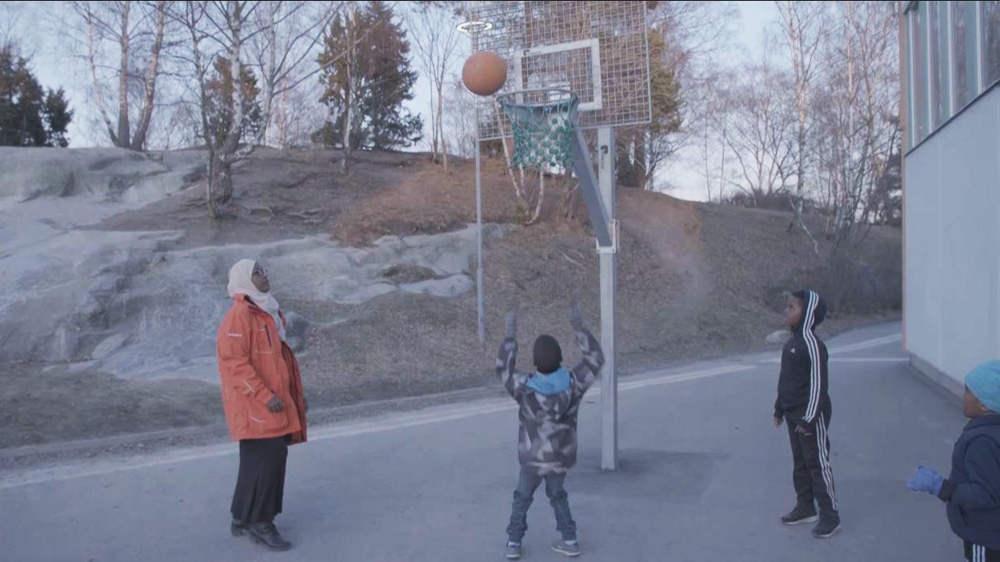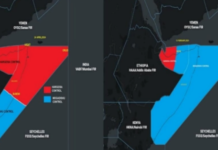Life in the Stockholm suburb of Rinkeby seen through the eyes of a mother fighting to improve life for its residents.
Iman was born in Somalia but has lived in Sweden for much of her life.
By day, she works for the municipality. But by night, she is one of a group of mothers who patrol the streets of Rinkeby, a suburb of the Swedish capital, Stockholm, to prevent crime and provide support to its young residents.
For many Swedes, it is a neighbourhood that has become synonymous with crime, violence and rioting. But for Iman and the other night patrol mothers, it is home – a place of comfort, of family, of hope.
This is her story. This is Rinkeby through her eyes.
“Rinkeby means a lot to me. It was the first place I came to in Sweden when I arrived [from Somalia] 26 years ago.
“I have lived here for more than half of my life. It’s a great place. I love the environment. It feels like home.”
Sometimes Rinkeby is referred to as Little Mogadishu on account of its large Somali population; around 90 percent of those who live there were either born outside Swedenor have parents who were. As well as Somalis, there are many residents of Eritrean, Ethiopian, Syrian, Bosnian, Polish, Turkish or Chilean descent, among other nationalities.
Iman was 13 when she fled the civil war in Somalia and says living in Rinkeby gave her a feeling of security.
“I do not feel alone. Here, you feel warm and welcome.”
“It is,” she says simply, “home.”
 |
| Iman works for the Rinkeby municipality. She is a part of a nightly patrol comprising mothers living in the suburb. [Al Jazeera] |
Hurt by negative stereotypes
She’s acutely aware of the area’s negative reputation but says it doesn’t bother her because she knows the truth.
“Of course, we have trouble here. But there is trouble everywhere.”
And, she stresses, residents are working to improve the area.
She blames the media for perpetuating negative stereotypes of Rinkeby and its residents and says she would like those who have heard bad things to ask people who live there what it is really like.
“The reporters come here only when bad things happen. But good things happen here, too.”
Following riots in Rinkeby and the nearby district of Husby in 2010 and 2013, national and international media coverage of Sweden’s suburbs intensified. But the theme was overwhelmingly one of ‘ungrateful immigrants’ and ‘no-go zones’, and few seemed to scratch beneath the surface to ask why young people, often born in Sweden but made to feel like outsiders, were rioting.
The strained relationship between the authorities and young non-ethnic Swedes who have long complained of racial profiling by the police is one of the many root causes residents point to. But this was little explored in the media, which mostly chose to vilify the rioters rather than speak to them.
Iman worries about how this one-sided and one-dimensional coverage of Rinkeby affects its young residents.
“It hurts them,” she says. “They live here. Their life is here.”
Fighting for Rinkeby’s youth
Most of the young people she meets love their community, she says, and would like to see more positive stories told about it.
“As parents, we support them and tell them the truth about themselves. [We tell them] they are part of this society …. We fight for them.”
But the pressure on them, she says, is huge.
“A lot of them feel part of Sweden. But the older they get, the more disappointed they become. These youths are part of this society, this is their country, too.”
As they struggle to find jobs and housing, Iman says their frustration builds.
According to Statistics Sweden and the Swedish daily newspaper Dagens Nyheter, which in 2015 mapped out ethnic segregation in 30 of Sweden’s largest municipalities, segregation between ethnic Swedes and those of other backgrounds has widened over the past two decades.
Immigration has been a key theme in this year’s general election, raised repeatedly in the media and by politicians, with integration ranked second in the list of voter concerns, according to an Ipsos poll conducted earlier in the year.
 |
| Iman is a keen basketball player and plays with a team set up by the night patrol mothers. [Al Jazeera] |
Gang killings
Iman believes that the negative portrayal of Rinkeby makes it harder for those who live there to be positive.
“Not everyone can handle it,” she says.
Some choose to move, but Iman wants to stay and help change the area for the better.
For the night patrol mothers, that means tackling the gang violence that has blighted their neighbourhood in recent years.
Since 2015, a series of gang-related retaliation killings have shaken Rinkeby. According to media reports, the murders were carried out by a so-called ‘death squad’ of young men aged between 17 and 19 and paid as little as 3,000 Swedish Krona (about $330) to kill.
The murders remain unsolved.
One case, the murder of two brothers inside a Rinkeby restaurant in 2015, touched particularly close to home for many of the mothers, who had known the brothers since they were young boys and say they weren’t troublemakers.
“That murder was the last straw for many mothers,” Iman explains. “… [They] thought ‘it could be my son next’.”
That was when they decided to form the night patrol.
“It was our way of showing that we can’t ignore this, that we need to take action ourselves, [that we need] to be more involved,” she says.
Iman believes these murders have exacted a heavy toll on the young residents of Rinkeby.
“I know it is [a] heavy grief on them,” she says. “Imagine someone you have known since [you were] a kid [is killed], [you] grew up with them, went to school with [them]. It is not easy to handle.”
It is a grief felt by the community as a whole, she adds.
“This is not a healthy environment for kids to grow up in. But we must keep thinking [about] how to improve it and better the environment for them. That is the main reason for our night patrol: to show the youth that we care about them.”
Iman believes that by patrolling the streets of Rinkeby, the mothers are able to break the patterns that lead to crime and violence.
“When we’re out, there’s less movement,” she says. “The youth [either] go home or, if not, [they] don’t do [those] things that might happen if adults weren’t around.”
The women employ many of the same skills they utilise as mothers.
“We talk to the young people. We don’t call the cops on them. We …become their friends… Most of the time they want to talk and to feel needed.”
 |
| Iman on patrol with another member of the mothers who routinely take to Rinkeby’s streets to help keep the peace. [Al Jazeera] |
A lesson for the police
Rinkeby hasn’t had a police station since 2014 and plans to open a new one, now scheduled for 2019, were repeatedly delayed when construction companies refused to work in the area out of fear their workers and equipment would be attacked. Despite this, there is a heavy police presence in the area, with at least two patrols at any time.
When it does open, the new police station will be the main one in the borough and is expected to house up to 250 police officers.
But Iman believes the police could learn something from the mothers’ approach.
“They do a lot, I know,” she says. “But they could still do much more. [They could have] more human contact with the youth; walk with them, play basketball, joke …. [Not just] sit in their cars and patrol.”
There is a place – and need – for both conventional policing and the mothers’ more personable approach, Iman believes.
But both must be motivated by a desire to understand the neighbourhood’s young people.
“I think the question should be ‘why are they reacting this way?’ No one is doing this [rioting] for fun. Sometimes they just focus on youth. [But] the focus should be why? The reason behind it. Is it frustration? Is it having nowhere to go? Why?”
And for those who have heard the negative stories about Rinkeby, Iman has one message: “Come here and visit. Do not believe what everyone else says. Just come here and see it for yourself if you want to know the truth.”
Across Europe, the far right is on the rise and it has some of the continent’s most diverse communities in its crosshairs.
To the far right, these neighbourhoods are ‘no-go zones’ that challenge their notion of what it means to be European.
To those who live in them, they are Europe. This is Europe is a series of films that tell their stories. Watch them here.
SOURCE: AL JAZEERA





































